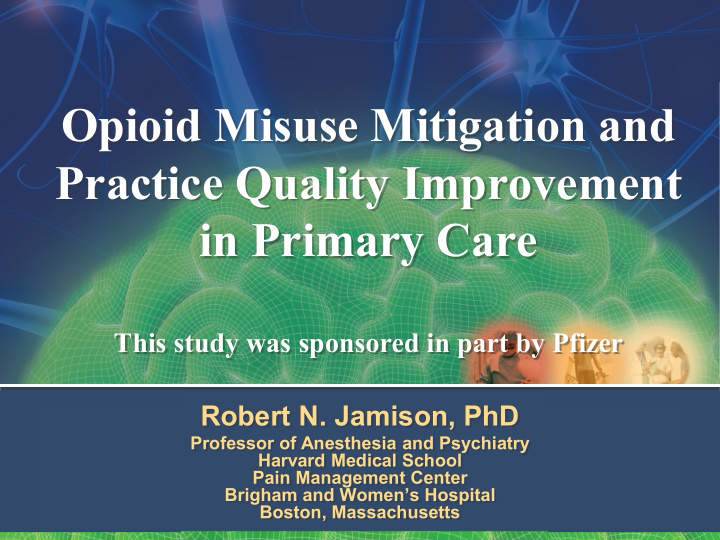



Opioid Misuse Mitigation and Practice Quality Improvement in Primary Care This study was sponsored in part by Pfizer Robert N. Jamison, PhD Professor of Anesthesia and Psychiatry Harvard Medical School Pain Management Center Brigham and Women’s Hospital Boston, Massachusetts
Primary Care Opioid Misuse Mitigation Study • The aim of this study is to determine whether careful patient monitoring and incorporation of a structured opioid therapy protocol with increased communication would improve provider confidence and patient compliance with prescription opioids. • We recruited 56 PCPs and monitored 253 pain patients for 6 months from 10 primary care centers. • We identified 5 Specialists centers (experimental) and 5 Generalist centers (control).
Provider Measures • Primary Care Provider Measures: – Background and Prescribing Practices Questionnaire – General Health Questionnaire – Opioid Therapy Survey – Concerns About Analgesic Prescriptions – Test of Opioid Knowledge – Addiction Behavior Checklist • All Providers were asked to complete the measures at baseline and one year later.
Patient Measures • Pain Patient Measures (baseline and 6 months): – Demographic Questionnaire – Brief Pain Inventory – Pain Catastrophizing Scale – Pain Disability Index – Hospital Anxiety and Depression Scale – Screener and Opioid Assessment for Pain Patients – Current Medication Misuse Measure • All patients were called once a month and completed assessments of their pain, activity, mood, side effects, and times in clinic and ED.
Specialist vs. Generalist Centers • The Specialist primary care centers received: – Patient risk assessment and monitoring – Information sessions and access to electronic medical record communication – Monthly feedback of patient progress – Coordination of treatment with pain center specialists • The Generalist primary care centers received: – Patient risk assessment and monitoring – Patient management by provider alone – No coordinated electronic medical record – No access to education sessions or monthly patient evaluations
Patient Results • Compliance was high with minimal dropout. • No differences were found between centers at baseline. • All patients reported greater compliance with their opioids by the end of the study. • Many of the patients (41%) felt that the monthly calls helped to prevent future problems. • Most (66%) felt that their doctors were more comfortable prescribing opioids and managing their pain by the end of the study.
PCP Results • After one year all providers remained concerned about opioid addiction and dependence and felt that chronic pain patients were stressful to deal with. • Overall, PCPs reported increased 1) confidence in identifying patients at risk for misuse, 2) confidence with prescription opioids, 3) ability to manage chronic pain patients in their practice. • Younger physicians had greater concerns about opioid misuse than older physicians.
Differences between Specialist and Generalist Groups • Few significant differences were found between groups at baseline. • Post-study, the Specialist Providers felt 1) that pain patients were less of a problem in their practice, 2) more confident in managing pain patients, 3) more satisfied with communication with pain specialists, including transition notes, 4) better able to identify patient risk, and 5) overall more comfortable in prescribing opioids. • The Generalists did not show these significant differences.
Conclusions Careful monitoring of patients from primary care centers who are prescribed opioids for chronic pain can be beneficial. Although many primary care clinicians have concerns about prescribing opioids, they are willing to prescribe for and manage chronic pain patients if they have suitable support, direction and information about their pain patients. Younger providers have greater concerns about prescription opioid user than older providers and greater attention in improving the knowledge and support of younger primary care providers should be encouraged
THANKS
Recommend
More recommend